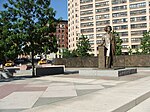110th Street station (IRT Ninth Avenue Line)

110th Street was a local station on the demolished IRT Ninth Avenue Line in Manhattan, New York City. It had two levels. The lower level was built first and had two tracks and two side platforms and served local trains. The upper level was built as part of the Dual Contracts and had one track that served express trains that bypassed this station. It opened on June 3, 1903 and closed on June 11, 1940. The next southbound stop was 104th Street. The next northbound stop was 116th Street. This station was one of the few to have elevators as it was the highest station in the entire system, also this height reportedly made this station very popular for suicide jumps. The common suicides, combined with the line's 90° turns from Ninth Avenue (now Columbus Avenue) onto Eighth avenue (now Frederick Douglass Boulevard), subsequently earned the station, and the area of track around it, the nickname Suicide Curve.According to Douglas (2004), the station was a popular site for suicide jumpers. In 1927, The New York Times reported that: The number of suicides from the 110th Street Station of the Sixth Avenue elevated is ruining the business of the merchants with shops below, according to [the merchants].... According to [a spokesperson] there were eleven suicides from that station in the past year, and the effect has been such that potential customers prefer to walk a little farther rather than risk seeing a person hurtle from above.
Excerpt from the Wikipedia article 110th Street station (IRT Ninth Avenue Line) (License: CC BY-SA 3.0, Authors, Images).110th Street station (IRT Ninth Avenue Line)
West 110th Street, New York Manhattan
Geographical coordinates (GPS) Address Nearby Places Show on map
Geographical coordinates (GPS)
| Latitude | Longitude |
|---|---|
| N 40.801116666667 ° | E -73.959638888889 ° |
Address
West 110th Street & Manhattan Avenue
West 110th Street
10026 New York, Manhattan
New York, United States
Open on Google Maps











